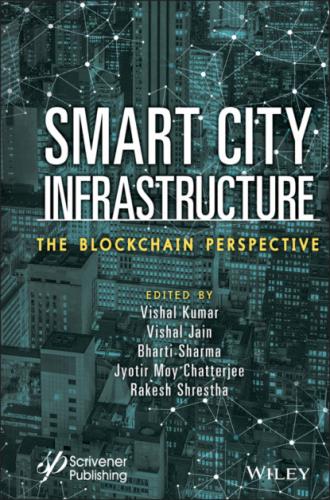Smart City Infrastructure. Группа авторов
rel="nofollow" href="mailto:[email protected]">[email protected]) Phillip Carmical ([email protected])
Smart City Infrastructure
The Blockchain Perspective
Edited by
Vishal Kumar
Department of Computer Science & Engineering, Bipin Tripathi Kumaon Institute of Technology, Dwarahat, India
Vishal Jain
Department of Computer Science & Engineering, Sharda University, Greater Noida, India
Bharti Sharma
School of Computing, Dehradun Institute of Technology, Dehradun, India
Jyotir Moy Chatterjee
Department of Information Technology, Lord Buddha Education Foundation, Kathmandu, Nepal
and
Rakesh Shrestha
Yonsei Institute of Convergence Technology, Yonsei University, South Korea
This edition first published 2022 by John Wiley & Sons, Inc., 111 River Street, Hoboken, NJ 07030, USA and Scrivener Publishing LLC, 100 Cummings Center, Suite 541J, Beverly, MA 01915, USA © 2022 Scrivener Publishing LLC
For more information about Scrivener publications please visit www.scrivenerpublishing.com.
All rights reserved. No part of this publication may be reproduced, stored in a retrieval system, or transmitted, in any form or by any means, electronic, mechanical, photocopying, recording, or otherwise, except as permitted by law. Advice on how to obtain permission to reuse material from this title is available at http://www.wiley.com/go/permissions.
Wiley Global Headquarters
111 River Street, Hoboken, NJ 07030, USA
For details of our global editorial offices, customer services, and more information about Wiley products visit us at www.wiley.com.
Limit of Liability/Disclaimer of Warranty
While the publisher and authors have used their best efforts in preparing this work, they make no representations or warranties with respect to the accuracy or completeness of the contents of this work and specifically disclaim all warranties, including without limitation any implied warranties of merchantability or fitness for a particular purpose. No warranty may be created or extended by sales representatives, written sales materials, or promotional statements for this work. The fact that an organization, website, or product is referred to in this work as a citation and/or potential source of further information does not mean that the publisher and authors endorse the information or services the organization, website, or product may provide or recommendations it may make. This work is sold with the understanding that the publisher is not engaged in rendering professional services. The advice and strategies contained herein may not be suitable for your situation. You should consult with a specialist where appropriate. Neither the publisher nor authors shall be liable for any loss of profit or any other commercial damages, including but not limited to special, incidental, consequential, or other damages. Further, readers should be aware that websites listed in this work may have changed or disappeared between when this work was written and when it is read.
Library of Congress Cataloging-in-Publication Data
ISBN 978-1-119-78538-5
Cover image: Pixabay.Com Cover design by Russell Richardson
Set in size of 11pt and Minion Pro by Manila Typesetting Company, Makati, Philippines
Printed in the USA
10 9 8 7 6 5 4 3 2 1
Preface
The goal of this book is to provide detailed, in-depth information on the state-of-the-art of the architecture and infrastructure used to develop smart cities using the Internet of Things (IoT), Artificial Intelligence (AI) and blockchain security—the key technologies of the Fourth Industrial Revolution. The book outlines the theoretical concepts, experimental studies and various smart city applications that create value for inhabitants of urban areas. Several issues that have arisen with the advent of smart cities and novel solutions to resolve these issues are presented. The IoT along with the integration of blockchain and AI provides efficient, safe, secure, and transparent ways to solve different types of social, governmental, and demographic issues in the dynamic urban environment. A top-down strategy is adopted to introduce the architecture, infrastructure, features, and security. The topics covered include the following:
– Chapter 1 starts with the basics of blockchain technology such as the design of blockchain, its elements, and functionalities. It then takes a deep dive into aspects of blockchain technology such as security, various types of consensus mechanisms, and application of blockchain technology in a smart city. Also discussed are the financial application and citizen-government framework, along with security and privacy issues and the future research direction of blockchain.
– Chapter 2 begins with the emergence and concept of the smart city. It discusses how new technologies such as the IoT can be utilized in the health industry, home automation, agriculture, supermarkets, transportation, etc.; and how they are interconnected to become a smart city. Technical innovations used in the smart city provide support for city management and transform natural resources, infrastructure, and intellectual assets into automation.
– Chapter 3 surveys the integration of blockchain and AI from the perspective of the smart city by presenting an in-depth review of various scientific research studies on the basics of blockchain and real-time applications. It then summarizes the applications and opportunities associated with blockchain, and the challenges involved in its use in smart cities.
– Chapter 4 explores the use of information and communication technologies (ICT) and AI along with the IoT in smart cities. It focuses on the issues facing increasing populations in urban cities around the globe and discusses the impact of implementing AI to change existing cities into the new smart cities of the future. Moreover, it discusses the applications in smart cities that reduce issues related to areas such as smart grid, agriculture, transportation, smart metering, etc.
– Chapter 5 discusses the use of blockchain in vehicle registration to support the smart city based on 5G technology. It presents a vehicle management system called DriveLoop, which is a simple method that allows car manufacturers, owners, repair companies, and insurance agencies to register and add new entries for cars. A detailed architecture view, algorithm, and working scheme for the DriveLoop application system is presented.
– Chapter 6 discusses
